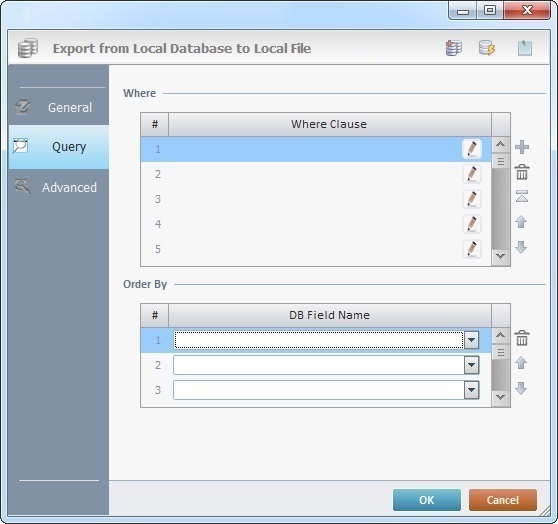Working with DB to Local File Process
Process Purpose
The "DB to Local File" process is used to export data from a local database table into a local file.
When you add a process, you are required to define its settings. This occurs in the process's properties window which is displayed automatically after having added the "DB to Local File" process. This properties window is constituted by three tabs - "General", "Query" and "Advanced".
If any subsequent edition is required, double-click the process to open its properties window and enter the necessary modifications.
"General" tab

Fill in the following options:
Export from Database Table (or View) |
|
Table Name |
Select the local database table/view used to export the records from the drop-down. If needed, click |
To Local File |
|
Local File Name |
Define the local file to receive the exported records OR click |
File Type |
Select the local file type from the drop-down (CSV, SCSV, Text (tab-separated values) or Text (pipe-separated values)). |
File Charset |
Select the character codification from the drop-down (UTF-8; ANSI, US_ASCII, windows-1252 or ISO_8859_1).
Ex: The Hindu character “अ” (included in a data file in use) can only be viewed with a “UTF 8” or “UTF-16 without BOM” encoding. The recommended codification for Android developed projects is "UTF-8" (or “UTF-16 without BOM”, if "UTF-8" is not available).
|
Add Header |
Check this option to include the table header in the local file. |
Continue to the "Query" tab.
"Query" tab

Proceed as follows:
Where |
|
Where Clause |
Click |
Order By |
|
DB Field Name |
Define the result order by selecting the appropriate table fields from the drop-down. |
Use the editing icons to the right of the table to move the rows up and down and to delete or add more rows.
Proceed to the "Advanced" tab.
"Advanced" tab

Option |
|
Field Mapping |
Check this option to enable the "DB Field Name/Local File Fields" columns. When enabled, it allows for the mapping of fields from the local database table/view into the local file fields. |
DB Field Name |
Organize the mapping by defining the selected database table fields from the drop-down into the corresponding local file fields. |
Local File Fields |
|
If … Go to |
|
SQL Error |
Select a target location from the drop-down or
|
Use the editing icons to the right of the table to move the rows up and down and to delete or add more rows.
Detail of a ![]() window:
window:

"S:Menu" is a screen included in the same program as the process.
"R:Routine_1" is a routine included in the same program as the process.
If required, use the icons on the top of the properties window:
![]() Click it to create a new table in a local database. See Creating a Table.
Click it to create a new table in a local database. See Creating a Table.
![]() Click it to test SQL scripts. See To Test SQL Scripts.
Click it to test SQL scripts. See To Test SQL Scripts.
![]() Use the icon to attach any relevant notes to this process. Click it and enter your notes in the resulting text box. These notes will be displayed in the corresponding "Actions" tab or "Process" window (in the "Notes" field) and in the "Developer Report".
Use the icon to attach any relevant notes to this process. Click it and enter your notes in the resulting text box. These notes will be displayed in the corresponding "Actions" tab or "Process" window (in the "Notes" field) and in the "Developer Report".
After filling in the required options, click ![]() to conclude or
to conclude or ![]() to abort the operation.
to abort the operation.
The added process is displayed in the corresponding "Actions" tab or "Process" window.
![]() You can use relative paths to refer the file(s) you want to use in your project. See Working with Aliases.
You can use relative paths to refer the file(s) you want to use in your project. See Working with Aliases.
![]() If you want to use a label as a target destination, you can use the "Auto-Label" mechanism. This alternative to the "Set Label" process allows you to create a label in the properties window of a process - specifically, in the fields used to define target destinations (ex: the "If Error..." type fields). See To Automatically Create a Label.
If you want to use a label as a target destination, you can use the "Auto-Label" mechanism. This alternative to the "Set Label" process allows you to create a label in the properties window of a process - specifically, in the fields used to define target destinations (ex: the "If Error..." type fields). See To Automatically Create a Label.
![]()
Use the right-click in MCL-Designer's input boxes to access some related options as well as the general "Cut", "Copy"; "Paste"; "Search" actions (active/inactive according to the current context).
Ex: If you right-click the "Variable" input box (included in a "Conversion's" properties window), you are provided with general editing/search actions and other more specific options such as "Variable Select" (see "Variable Select"); "Variable Insert" (see "Variable Insert"); "Insert Special Character" (see To Insert Special Characters into a Control's Text Input Field) and "Localization Select" (see Localization List).
If you right-click another input box, it may provide other possibilities.
